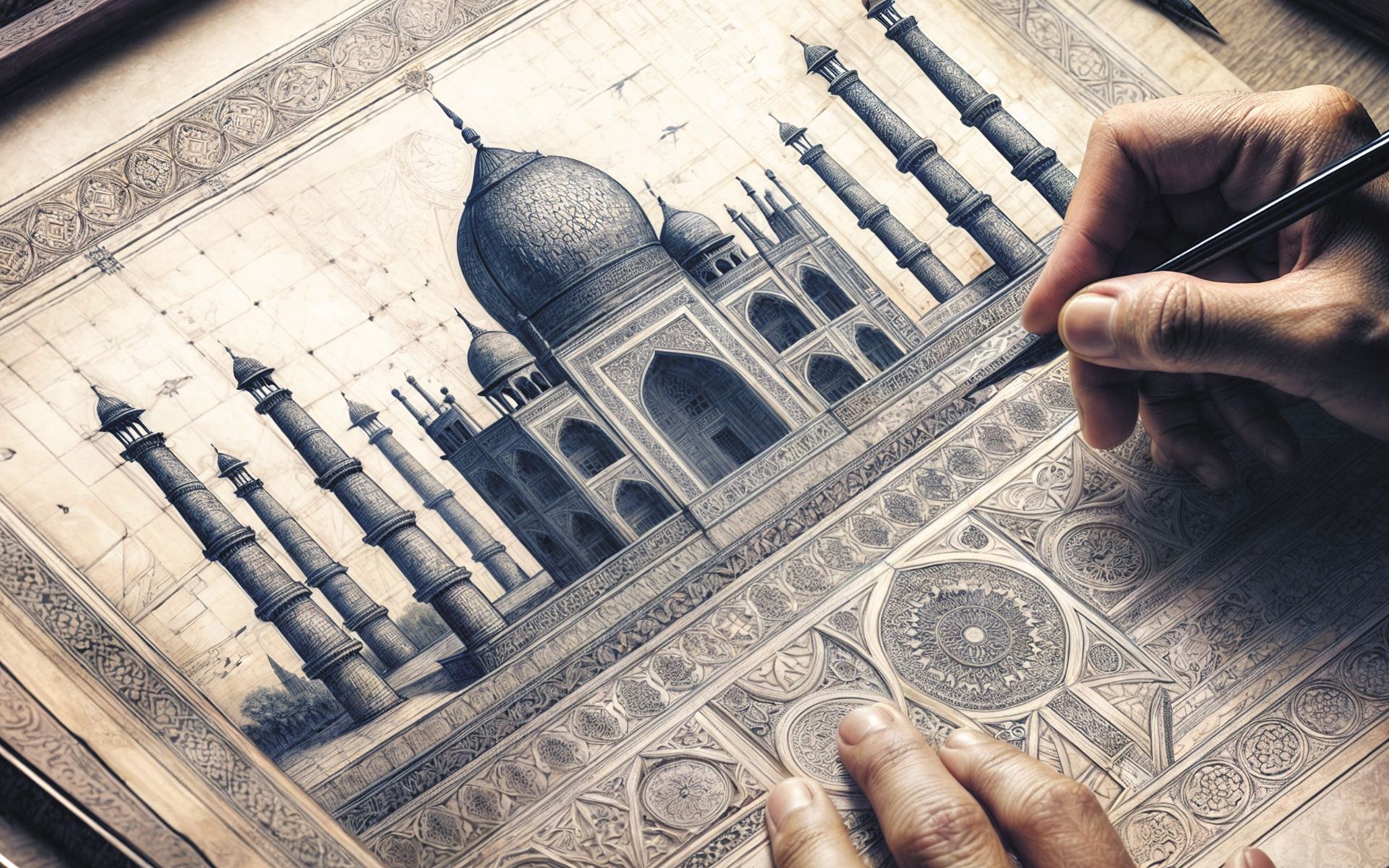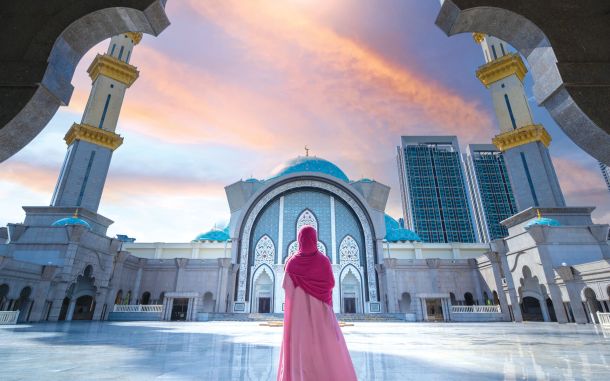Islamic Art and Architecture

In This Article
-
Islamic art and architecture transcend beyond the realm of mere physical aesthetics, and rather serve as profound expressions of philosophical and spiritual profundity.
-
Islamic art and architecture, steeped in the quintessence of Islamic philosophy, is a manifestation of the sublime appreciation of the divine that imbues the universe.
-
The artistic and architectural heritage of the Islamic world is grounded in the theological principles of Islam, which emphasize the significance of unity, balance, and harmony.
As the sun rose over Agra, casting an orange hue on the horizon, I approached the Taj Mahal, one of the world's most breathtaking examples of Islamic art and architecture. Standing before the massive structure, I was awed by its intricate details and the spiritual aura it radiated.
The Taj Mahal, built by Mughal emperor Shah Jahan in memory of his wife Mumtaz Mahal, is a testament to the exquisite beauty and grandeur of Islamic art. From the moment I set foot on its grounds, the complex patterns and designs covering every surface captivated me.
Entering the main gate, I was greeted by a reflecting pool mirroring the towering white marble structure. The Taj Mahal's symmetrical layout, with its four minarets and central dome, exemplifies the Islamic concept of balance and harmony.
Approaching the entrance to the tomb, I admired the delicate carvings and ornate calligraphy on the walls and ceilings. Every motif held deep spiritual significance.
It was clear that the builders of the Taj Mahal aimed to bridge the material and spiritual realms through art and architecture. The building's beauty reflects the nobility of the material world, while its designs and symbolism remind us of the deeper spiritual realities beyond. As I stood before the tomb of Mumtaz Mahal, I felt a profound sense of peace and tranquility wash over me. The spiritual energy of the Taj Mahal seemed to permeate every inch of the building, filling me with a sense of awe and wonder.
The Taj Mahal showcases the artistic excellence and architectural brilliance of its era. Its breathtaking designs are a tribute to the artisans' skills, while its grand proportions reflect the enduring power of the material world. However, the Taj Mahal's significance extends beyond its physical beauty; it symbolizes the eternal truths that lie beyond the material world and serves as a reminder of the spiritual realm at the heart of existence.
The historical perspective on the Taj Mahal's significance has recently transformed from a mere symbol of love to a representation of Paradise, intricately linked to the notion of the Last Judgment. This transformative view stems from the research of Wayne Edison Begley, who published Taj Mahal: The Illumined Tomb (1989). Begley proposed that the Taj might symbolize the heavenly Throne of God, which tradition situates above Paradise, where God will sit in judgment on the Day of Resurrection. Top of Form
Viewed as a cohesive unit, encompassing its walls, south buildings, gardens, and terrace, the Taj Mahal conveys a unique and complex symbolic message. The monument's meaning is so intertwined with its architectural components that any omission or alteration would compromise its symbolic intent. Even minor changes, such as altering materials or reconfiguring gardens, would impact the symbol it represents. Contemporary texts on the Taj Mahal's creation, particularly those by Begley, highlight its association with the "Plain of Assembly," the eschatological place of the Last Judgment. The layout of the Taj complex and its apocalyptic imagery suggest it was conceived as an allegory of the Day of Resurrection. This interpretation finds a parallel in Ibn al-Arabi's diagram of the "Plain of Assembly" from Futuhat al-Makkiyya. The rectangular area of the Taj Mahal is surrounded by rows of angels, resembling the boundaries of its gardens. The Throne of God, borne by eight angels, is symbolized as an eight-pointed star near the mausoleum's octagonal shape. This throne is flanked by the four righteous—the mosque and the guest pavilion—and the Angel Gabriel below. The central basin aligns with the Prophet's location, where souls are weighed. The Taj Mahal's gardens symbolize Paradise, while the eschatological manuscript shows Paradise on the right and Hell on the left, with a bridge for the righteous to cross. Though not a perfect representation, the Taj Mahal's design aligns with Islamic depictions of the afterlife.
Islamic art and architecture transcend beyond the realm of mere physical aesthetics, and rather serve as profound expressions of philosophical and spiritual profundity. They are emblematic of Islamic beliefs, values and culture, and convey the essence of Islamic theology through their designs, geometric patterns, and calligraphic displays. These fine points and artistic manifestations of Islam are reflective of the Islamic worldview, which places the idea of the sole creatorship of the universe to God and considers everything within it as a reflection of His magnificence. Through Islamic art and architecture, the quest to capture the beauty and perfection of God's creation is accomplished. The exquisitely detailed patterns and designs serve as a tangible representation of the essence of Islamic beliefs, values and culture. Furthermore, the ornate subtleties of Islamic art and architecture are intended to inspire a sense of wonder and amazement at the splendor of God's creation.
Islamic art and architecture, steeped in the quintessence of Islamic philosophy, is a manifestation of the sublime appreciation of the divine that imbues the universe. The rich spirituality and profound philosophical depth that enshrouds Islamic art and architecture bear witness to the highest form of creativity, inspired by the magnificence of God's creation. Its foundation is rooted in the Islamic interpretation that prohibits the representation of living beings, paving the way for a distinctive art style that cherishes non-representational forms like geometric shapes, calligraphy, and arabesque patterns. Islamic art, therefore, is not merely an aesthetic expression but also an embodiment of symbolic expression that conveys an underlying message of deep reverence for the divine.
The strict prohibition on the representation of living beings in Islamic art has been instrumental in shaping the unique style that it embodies. The focus on non-representational forms such as geometric shapes, calligraphy, and arabesque patterns is a remarkable deviation from the conventional art styles. However, this distinctive style serves a purpose that goes beyond aesthetics. It symbolizes the recognition of the divine, the power that is greater than the material world, and a celebration of the non-material essence of the universe. Thus, the art of Islam is a precise and symbolic representation of the highest form of spirituality.
The artistic and architectural heritage of the Islamic world is grounded in the theological principles of Islam, which emphasize the significance of unity, balance, and harmony. The paramount goal of Islamic art and architecture is to communicate the fundamental interconnectedness of all creation, the harmony between the individual and the universe, and the equilibrium between the material and spiritual realms. Additionally, Islamic art and architecture seek to embody the spiritual and intellectual ideals of Islam.
Tawhid
The genesis of Islamic art and architecture can be traced to pre-Islamic Arabian art and the styles of the Byzantine and Sassanid empires. During the seventh century and beyond, with the rise of the Islamic caliphate, art and architecture evolved significantly. Islamic artists and architects drew inspiration from diverse cultures, including Persian, Egyptian, Syrian, and Iraqi traditions, skillfully blending these influences into a unique Islamic style. This fusion of artistic traditions contributed to a rich and complex Islamic art and architecture that became a hallmark of Islamic civilization for centuries. At the very heart of Islamic art and architecture lies the principle of tawhid, an embodiment of the belief in the singular and indivisible nature of the divine. It is this principle that finds expression in the meticulous geometric patterns that abound in Islamic art, which, by their very design, reflect the unity and infinitude of God. These patterns, constructed from a complex web of interlocking squares and circles, represent an eternal, unbroken chain of unity that echoes the timeless nature of divinity.
Moreover, Islamic art and architecture is characterized by a striking symmetry and balance that serves to mirror the natural harmony of the universe, seen by adherents as a divine reflection of God's will. This principle is imbued in the very fabric of Islamic art, from the carefully carved designs of the ubiquitous tiles adorning mosques and palaces, to the stunning calligraphy that adorns countless Islamic manuscripts. Through such exquisite attention to detail, the unity of God is celebrated and immortalized in the very foundations of Islamic art and architecture, a testimony to the lasting impact of this profound spiritual tradition. In The Topkapi Scroll: Geometry and Ornament in Islamic Architecture, Gulru Necipoglu maintains:
“… geometric patterns as eternal archetypes that could lead the contemplative mind from outer appearances to the esoteric inner realities of Sufism through spiritual hermeneutics.”
Ihsan
At the essence, the concept of ihsan is a profound and multifaceted notion that encapsulates the pursuit of excellence, beauty, and righteousness. It is an ethical and spiritual ideal that informs every aspect of Islamic culture, including the arts and architecture. In the context of Islamic art and architecture, ihsan is manifested in the meticulous attention to detail, exquisite craftsmanship, and superior quality of materials employed in the creation of objects and structures. These elements serve as tangible expressions of the artist's and architect's devotion to God, and their commitment to upholding the highest standards of artistic and ethical excellence. Whether in the intricate geometric patterns adorning a mosque's mihrab, the ornate calligraphy adorning a Qur'an, or the exquisite tilework gracing a palace's façade, the Islamic artist and architect strive to embody the ideals of ihsan in their work.
As such, ihsan plays a crucial role in shaping the aesthetic and spiritual landscape of Islamic culture. It is an invitation to approach artistic creation not merely as a means of self-expression or aesthetic pleasure, but as a profound act of worship and devotion. By infusing their work with ihsan, Islamic artists and architects transform the ordinary into the extraordinary, elevating the material to the spiritual and transcending the boundaries of time and space.
Barakah
Islamic art and architecture manifest the concept of barakah, embodying the belief in God's blessings and abundance. These art forms inspire serenity and awe, reflecting the beauty of God's creation. They bear witness to Islamic values, revering the natural world as a divine expression and a source of inspiration. Islamic art and architecture often feature gardens, fountains, and natural elements that convey peaceful harmony, encouraging reflection on God's eternal beauty. With intricate patterns, vibrant colors, and precise details, these masterpieces elevate the human spirit, reflecting the enduring blessings of God.
Islamic architecture is a resplendent display of the artistic excellence and cultural values that have thrived in the Islamic world over the centuries. As an intrinsic extension of Islamic art, this architectural style showcases a striking blend of fine designs, ornate patterns, and symbolic motifs that have been imbued with profound religious significance. “Islamic art is at last revealed to be what it really is, namely the earthly crystallization of the spirit of the Islamic revelation as well as a reflection of the heavenly realities on earth, a reflection with the help of which the Muslim makes his journey through the terrestrial environment and beyond to the Divine Presence Itself, to the Reality which is the Origin and End of this art” (Necipoglu 1995, p. 96).
One cannot help but marvel at the striking characteristics of Islamic art and architecture, notably its masterful use of calligraphy. This art form is held in high esteem and is considered the quintessential expression of Islamic art. Islamic calligraphy is the embodiment of the beauty and grandeur of the Qur’an, the holy scripture of Islam, and serves as a testament to the religion's rich cultural heritage. Its complex and deliberate strokes serve to evoke a sense of spiritual and intellectual resonance that is emblematic of the Islamic faith.
Domes
Another remarkable feature of Islamic architecture is the integration of domes and arches, as these architectural elements symbolize the unity of the cosmos and the indivisible connection between humanity and the universe. In his “Islamic Art and Spirituality” Seyyed Hossein Nasr rightly adds:
“The more one penetrates into the significance of Islamic art the more one becomes aware of the most profound relationship between this art and Islamic spirituality … traditional Islamic art was created by an inspiration which issued ultimately from the Muhammadan “barakah” and with the aid of a “hikmah” which resides in the inner dimensions of the Noble Quran. To grasp fully the significance of Islamic art is to become aware that it is an aspect of the Islamic revelation, a casting of the Divine Realities (haqa'iq) upon the plane of material manifestation in order to carry man upon the wings of its liberating beauty to his original abode of Divine Proximity” (Nasr 1987).
Islamic art and architecture are rich in symbols that resonate with Islamic culture, with every detail imbued with profound meanings integral to the faith. The crescent moon, star, and five-pointed star are prominent symbols. The crescent moon and star, linked to the lunar-based Islamic calendar, signify new beginnings and divine guidance. The five-pointed star, representing the five pillars of Islam—Shahada, Salat, Zakat, Sawm, and Hajj—serves as a framework for Muslim life.
These symbols in Islamic art and architecture convey the spiritual and intellectual values of Islam, reminding us of its enduring legacy. They are inseparable from Islamic culture, reflecting unity, balance, and harmony, and are a testament to the faith's rich heritage. Islamic art and architecture are characterized by geometric and floral patterns, calligraphy, plays of light and shadow, and architectural elements like domes and arches. They epitomize the magnificence and spiritual tenets of Islam, serving as an integral part of Islamic culture.
References
- Bloom, J. M. (2017). The Art of Islam: Language and Meaning. Yale University Press.
- Denny, W. B. (2010). Islamic Art and Architecture. Thames & Hudson.
- Golombek, L., & Wilber, D. (1988). The Timurid Architecture of Iran and Turan. Princeton University Press.
- Grabar, Oleg. (1987). The Formation of Islamic Art. New Haven: Yale University Press.
- Ibn Arabi, M. (1996). Al-Futuhat al-Makkiyah (The Meccan Revelations) (A. A. S. Al-Mansoub, Ed.) (4th ed., Vols. 1-14). Dar Sadir.
- Khoury, N. (1983). Islamic Architecture: A Critical Introduction. G. Braziller.
- Nasr, S. H. (1987). Islamic art and spirituality. Traditional Hikma. Retrieved from https://traditionalhikma.com/wp-content/uploads/2015/03/Nasr-Seyyed-Hossein-Islamic-Art-and-Spirituality-1987-html-copy.pdf
- Necipoğlu, G. (1995). The Topkapi Scroll: Geometry and Ornament in Islamic Architecture. Getty Publications. Retrieved from https://www.getty.edu/publications/virtuallibrary/pdf/9780892363353.pdf (p. 92).
- Rabbat, N. (2006). Islamic architecture: past, present, future. The Aga Khan Program for Islamic Architecture, Massachusetts Institute of Technology.
- Suleiman, Y. (2005). The Concept of Tawhid in Islamic Art. Journal of Islamic Studies, 16(1), 27-49.
- Wayne Begley, “The Myth of the Taj Mahal and a New Theory of its Symbolic Meaning,” Art Bulletin, vol 61, no 1, March 1979, pp. 7-37.









